Featured Video
Siakam, Reporter Get Into It 😡
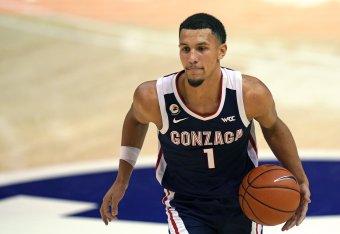
2021 NBA Draft Big Board: Updated Top 50 Players
With the G League kicking off, new storylines and scouting opportunities have come up within the 2021 NBA draft discussion.
That calls for an update to our big board.
Scouts have flocked to the Disney bubble to get their first looks of the year at Jonathan Kuminga, Jalen Green, Daishen Nix and Isaiah Todd. And so far, the experience has been a success both for NBA teams and prospects.
But college basketball continues to roll along as well, and there continues to be plenty to discuss, from the projected top picks to emerging sleepers.
Nos. 50-41
1 of 14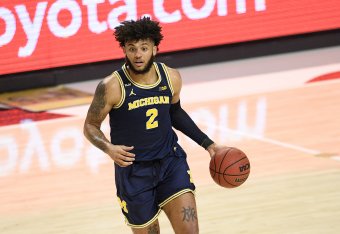
50. Chris Duarte (Oregon, SG, Senior)
From junior college Player of the Year to Oregon and now NBA watch lists, Duarte has emerged as a three-and-D pro prospect, shooting 53.3 percent, 44.2 percent from deep and 84.4 percent at the free-throw line while averaging 2.4 steals.
49. David Duke (Providence, SG, Junior)
A recent slump has exposed some of Duke's struggles finishing in traffic. But for a 6'5" guard, he's still developed shot-creation skills, a reliable three-ball and secondary playmaking that should earn Duke a spot in the second-round mix.
48. Luka Garza (Iowa, C, Senior)
NBA teams will have to hide Garza on defense, which will limit the amount of minutes he plays. But for the right team in a specified role, he could help a rotation with his physical inside play and improved shooting.
47. Joel Ayayi (Gonzaga, PG/SG, Junior)
NBA teams could picture Ayayi playing the same role he excels in at Gonzaga, where he thrives as a secondary playmaker (97th percentile pick-and-roll ball-handler), off-ball cutter (88th percentile) and opportunistic shooter off the catch and dribble. The fact that he's making 70.9 percent of his twos and averaging 7.2 rebounds per game (at 6'5") bodes well for Ayayi's ability to handle stronger NBA athletes.
46. Aaron Henry (Michigan State, SG/SF, Junior)
The three-ball may make or break Henry as an NBA prospect, but in the second round, it's worth gambling on, given his 6'6" size, slashing ability, passing, defensive tools/anticipation and rising free-throw percentage (81.0 percent), a promising number that highlights shooting touch.
45. Isaiah Jackson (Kentucky, PF/C, Freshman)
A non-threat offensively, Jackson could still carve out a defensive specialist role, given how effective he is using his athleticism and timing to block shots (13.5 block percentage). He just won't have any margin for error finishing around the basket, where he'll either need to become automatic or surrounded by the right mix of shooters.
44. Isaiah Livers (Michigan, SF, Senior)
Shooting, defense and reliable late-game play illuminate role-player potential for Livers, who's also scored at least 20 points in three consecutive games and is now hitting 45.7 percent of his threes and 91.9 percent of his free throws on the year.
43. Justin Champagnie (Pittsburgh, SF/PF, Sophomore)
Shooting 58.3 percent inside the arc, averaging 11.6 rebounds and 1.2 blocks, Champagnie plays bigger and tougher than 6'6", 200 pounds. He does most of his work from the elbows to the rim, scoring around the key, cutting and hitting the offensive glass. Champagnie has been off from three since knocking down four of them against North Carolina on January 26, but he's still been a useful shooter as a sophomore, making 46.9 percent of his spot-up attempts.
42. Kessler Edwards (Pepperdine, SF, Junior)
Edwards has cooled off since scoring 37 points against Pacific in January, but he's been a consistent shooter through three seasons at Pepperdine, and his 6'8" size, shot-making versatility and accuracy should be enough to draw plenty of NBA looks.
41. Tre Mann (Florida, PG, Sophomore)
Mann's improvement should lead to NBA interest from teams who value his creativity and buy his 40.9 percent three-point shooting. However, it's more realistic to picture him as a bench spark than a starting lead guard, which could keep him from climbing into the first-round mix.
Nos. 40-31
2 of 14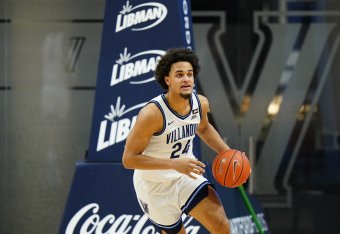
40. Ayo Dosunmu (Illinois, PG/SG, Junior)
It's tough to pinpoint Dosunmu's most translatable skill, but he's sharp and productive enough with each (for a 6'5" guard) to justify draft looks and carve out an NBA role. His shot-making versatility and footwork for scoring seem more appealing than his playmaking.
39. Taevion Kinsey (Marshall, SG, Junior)
Coming off consecutive 25-point games during a back-to-back against Rice, Kinsey continues to efficiently score (20.4 points, 56.9 percent FG) with his elite leaping at the rim and improved shot-making skill in the mid-range. Despite limited three-point attempts, he's hitting the ones he's taking (16-of-36).
38. Bennedict Mathurin (Arizona, SF, Freshman)
Shooting 42.7 percent from three, Mathurin is catching eyes with his smooth stroke for an athletic, 6'7" wing. Ranking in the 93rd percentile out of spot-ups, he's also 21-of-31 at the rim, and though not the most creative scorer or passer, his bounce is explosive enough to help Mathurin finish plays as a line-driver and cutter.
37. Miles McBride (West Virginia, PG, Sophomore)
McBride has transformed from an energizer and defensive pest to a lead guard West Virginia can count on for offense late in games. Speed and peskiness still may be his most attractive traits for NBA teams, but his shot-making versatility and playmaking have become worth valuing as well.
36. Day'Ron Sharpe (North Carolina, C, Freshman)
Impressive passing differentiates Sharpe, and he'll draw interest because of his motor and activity around the basket at both ends. He still figures to be more of a Plan B for teams unless he surprises them in workouts with hidden shooting skills.
35. Rokas Jokubaitis (Zalgiris, PG/SG, 2000)
With 21 assists over his last four games, Jokubaitis has been playmaking more, which helps ease some of the pain from a current shooting slump. He ultimately deserves first-round looks for his combo-guard versatility, skill level, craftiness and IQ.
34. Terrence Shannon Jr. (Texas Tech, SG/SF, Sophomore)
Shooting is a swing skill that could unlock Shannon's NBA potential. At baseline, he's appealing for his 6'6" frame, athletic slashing and defensive quickness. His jumper looks better this season (17 threes in 19 games), and he's been effective from the mid-range and free-throw line (80.5 percent). But without much creation and playmaking skills, it still seems safer to bet on his 29.8 percent three-ball in the late 20s or 30s.
33. Ariel Hukporti (Nevezis Kedainiai, C, 2002)
An immediate standout for his 7'0", 250-pound frame, movement and athleticism, Hukporti has also delivered some enticing flash plays of skill as a face-up scorer and shooter. He's still rough around the edges in terms of perimeter execution and picking his spots, but Hukporti can make unique plays for an 18-year-old with his particularly body.
32. Jeremiah Robinson-Earl (Villanova, PF, Sophomore)
Inconsistency makes it difficult to confidently assess Robinson-Earl, who recently followed a 27-point game on 5-of-5 shooting from three against Marquette with a 3-of-13 dud in a loss to Creighton. Lacking quickness and athleticism, he needs his jumper to become more reliable, but his mechanics appear promising. And since high school, he's demonstrated a high skill level and IQ working from the elbows as a scorer and passer.
31. Marcus Bagley (Arizona State, PF, Freshman)
Buying Bagley means believing the eye test on his three-ball and valuing it for a 6'8" forward. He doesn't create, and he's shooting only 36.2 percent from deep, but his shot mechanics and fluidity are highly persuasive, and he has enough athletic ability and tools to finish plays and defend his position.
Nos. 30-21
3 of 14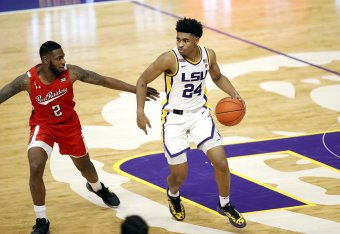
30. Nah'Shon Hyland (VCU, SG, Sophomore)
Averaging 3.2 threes per game on 38.9 percent shooting, Hyland is auditioning for an NBA shot-making specialist role. He doesn't offer much playmaking, but between his shooting versatility, deep range and scoring confidence, a team looking for an offensive bench spark could target him.
29. Roko Prkacin (Cibona, PF, 2002)
A recent 5-of-5 three-point performance in the Croatian League highlighted shooting potential that could elevate Prkacin in the draft conversation. He isn't the most advanced creator or scorer in the half court, but for a 6'9" forward, his ability to slash, pass and hit set jumpers should suit him well on an NBA floor.
28. Josh Giddey (Adelaide 36ers, PG/SG, 2002)
NBA teams should be able to bank on Giddey's passing, given his 6'7" size for a ball-handler, 5.5 assists and obvious vision/IQ. But he could have trouble scoring without much explosion or strength. Giddey's shooting development will help unlock more upside. He's struggled from deep for the season, though he did hit three three-pointers Monday.
27. David Johnson (Louisville, PG/SG, Sophomore)
Louisville's last game was February 1, but it was Johnson's best of the season (24 points, 10 rebounds, 6-of-11 3PT) and a promising shooting performance confirming his jump-shot development. He isn't showcasing much playmaking, although teammate Carlik Jones has been tasked with setting up teammates.
26. Charles Bassey (Western Kentucky, C, Junior)
Regular flashes of three-point shooting (9-of-19 over his last eight games) have helped push Bassey into our top 30 after last year's leg injury took him out of the 2019-20 conversation. He'll still be valued most for his shot-blocking (3.2 per game), but Bassey has developed into a more appealing offensive player with touch around the basket and improving range on his shot.
25. Jared Butler (Baylor, PG/SG, Junior)
While it's tough to picture Butler turning into a high-level NBA scorer or playmaker, he's become too well-rounded to let slip into the 30s. Shooting 44.6 percent from three while averaging 5.2 assists and 2.4 steals, Butler looks like an easy fit and rotation guard in the NBA.
24. Cameron Thomas (LSU, SG, Freshman)
Between Thomas' ability to easily separate, shot-make from deep and draw fouls, he has hit the 20-point mark 14 times through 19 games. He's instant offense, although it's fair to question how efficiently he'll execute without a 33.4 usage rate and bright green light in the NBA.
23. Alperen Sengun (Beskitas, C, 2002)
The Turkish BSL's third-leading scorer at 18 years old, Sengun has been too effective against pros for questions about his older-school game to limit interest. He's a post player, but he's a sharp one with terrific footwork, counters and bounce to rise up for big finishes and blocks.
22. Josh Christopher (Arizona State, SG, Freshman)
Christopher has the athleticism, creation moves and shot-making skills to score in the NBA. It may take a few years before his team sees consistent results based on his difficult shot selection and erratic three-point shooting, though.
21. Daishen Nix (G League Ignite, PG, 2002)
Praised more for passing out of high school, Nix has quickly started to answer questions in the G League about his lack of burst and scoring potential. Averaging 11.3 points in 24.1 minutes, he's creating for himself with decisive ball-handling and timely change of speed, and he's making shots, bouncing off contact and converting with body-controlled finishes.
Nos. 20-11
4 of 14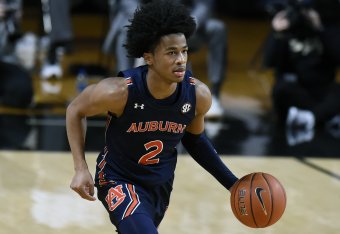
20. Davion Mitchell (Baylor, PG, Junior)
Averaging 23.7 points and 5.3 assists on 15-of-22 from three over Baylor's last three games, Mitchell seems to be turning another corner as a prospect. Already an outstanding perimeter defender entering the season, he's quickly evolving offensively, having started the year showing improved playmaking and shooting, and now elevating his scoring ability with more flashes of shot-creation and shot-making off the dribble.
19. Brandon Boston Jr. (Kentucky, SF, Freshman)
Now 11-of-18 from three over Kentucky's last four games, Boston is finally settling in. Questions remain about his creation and one-on-one execution, but for a 6'7" wing, his slashing and shot-making skills are still worth targeting in the first round.
18. Greg Brown (Texas, PF, Freshman)
Brown's identity revolves around highlight-reel bounce, but his shooting potential continues to pop, with the 6'9" freshmen having hit seven of eight threes over Texas' last two games. The combination of athleticism and range creates enough theoretical upside to overshadow his suspect feel for the game (42 turnovers, five assists) and defensive discipline.
17. Corey Kispert (Gonzaga, SF, Senior)
At 47.9 percent from three, Kispert is one of the more convincing shooting prospects in recent memory. Even if the volume scoring (19.2 points per game) doesn't translate, the fact that he's converting 63.9 percent of his twos is a good sign for his potential to finish plays that aren't just designed for him to catch-and-shoot.
16. Sharife Cooper (Auburn, PG, Freshman)
Cooper keeps racking up the assists (8.6 per game) with translatable playmaking skills fueled by his creative ball-handling and terrific live-dribble passing. However, at 6'1", problems finishing (43.9 percent) and shooting (24.8 percent 3PT) are raising questions about his NBA scoring potential.
15. Usman Garuba (Real Madrid, PF/C, 2002)
Garuba still isn't scoring much, but he's impacting games when in with his defensive energy, picking up full court, switching, anticipating shots and forcing turnovers. He's special enough defensively to the point where teams should accept the lack of offense if they can get Garuba in the mid-first round.
14. Franz Wagner (Michigan, SF, Sophomore)
The selling point to Wagner focuses on his fit and how the NBA values his particular skill set and strengths. He doesn't project as a volume scorer, but the ability to shoot, pass and defend at a high level could help Wagner earn a sizable role.
13. Kai Jones (Texas, C, Sophomore)
Despite the limited production for a player with a lottery grade, I'm buying the flashes of open-floor speed, athleticism for finishing and shot-blocking, footwork driving and defending and shooting touch (10-of-24 3PT). There is only so much consistency or dominance one can expect with a 16.9 percent usage.
12. Jalen Johnson (Duke, PF, Freshman)
Johnson is done at Duke after losing minutes of what's become a rare lost season for the Blue Devils. There are bound to be NBA teams who bash the decision and call it quitting. For me, the bigger concern is his shooting and half-court scoring. But he still deserves consideration from late-lottery teams for his ability to handle and pass at 6'9", as well as make off-ball plays as a cutter (14-of-17) and defender (1.2 steals, 1.2 blocks per game).
11. James Bouknight (Connecticut, SG, Sophomore)
Out since early in January (elbow), Bouknight returned Tuesday night with 18 points against Providence. Averaging 20.3 points through six games coming in, the 6'5" combo had quickly emerged as a breakout name in this year's draft discussion, drawing attention with a persuasive mix of shifty ball-handling for creation, tough shot-making and athletic finishes—plus a 40-point game against Creighton. It's worth questioning how to use him at the NBA level, whether he's built to play point guard or just to score. Showcasing more playmaking the rest of the way opens a door for Bouknight to crack the top 10.
10. Scottie Barnes (Florida State, PF, Freshman)
5 of 14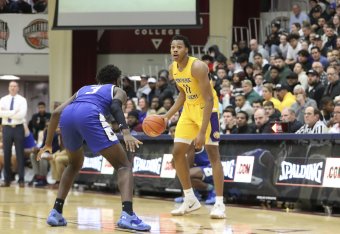
Scottie Barnes' out-of-the-box game has scouts divided. I'm on the side that believes in his ability to make an impact without needing to score.
Defense may be his biggest selling point early on given his unique blend of 6'9", 227-pound size, lateral foot speed and interest in blanketing ball-handlers from baseline to baseline.
Offensively, NBA teams figure to use him as a playmaking 4. Barnes lacks self-creation skills, but he excels as a live-dribble passer in transition and ball-screen situations. And though he's missing a pull-up game, Barnes activates his length and his large hands for finishing off slashes and runners around the key.
Shooting just 26.7 percent from three and 52.1 percent on free throws, the unconventional forward may just need the right team fit to optimize his versatility.
9. Ziaire Williams (Stanford, SF/PF, Freshman)
6 of 14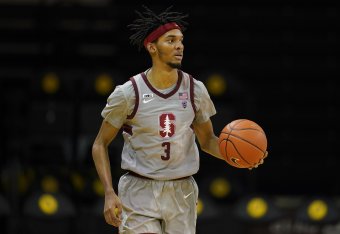
Though COVID-19 protocols have limited Ziaire Williams to just three games since January 16, his strengths and weaknesses are already well defined. And Williams' strengths figure to translate and eventually create an archetype that's valued by NBA teams.
The percentages aren't pretty (31.1 percent from beyond the arc), but having watched the 6'8" forward closely throughout high school, shooting is a plus on his scouting report. Williams has textbook form off the catch and dribble, as well as the footwork and skill to create separation into balanced pull-ups and step-backs.
An advanced perimeter scorer, Williams also makes plays with his ball-handling, initiating fast breaks or running pick-and-rolls. And his physical tools, quickness and IQ bode well for his defensive projection.
Limited burst for blowing by defenders and weak explosiveness to finish just suggest Williams projects as more of a complementary piece than a featured go-to option.
8. Moses Moody (Arkansas, SG, Freshman)
7 of 14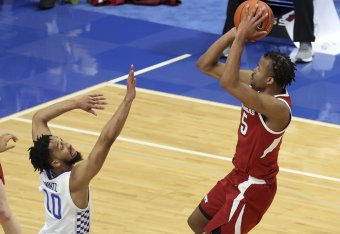
Moses Moody continues to build his lottery case around a safe mix of shooting and defense for a 6'6" wing.
Limited on-ball work or flashes of creativity could make it difficult for the freshman to climb much higher on the board. But he appears to be an easy fit and a valuable type of player for every NBA team based on his three-ball (1.8 3PTM, 37.8 percent), pull-up game (14-of-30) and tools for guarding the perimeter.
Offensive rebounding (20 putbacks) has been a surprise contribution from Moody, who's using the glass for opportunities. He's averaging 16.3 points on 45.3 percent shooting from the field, consistently finding ways to score off the ball without featured ball-handling touches.
7. Jaden Springer (Tennessee, PG/SG, Freshman)
8 of 14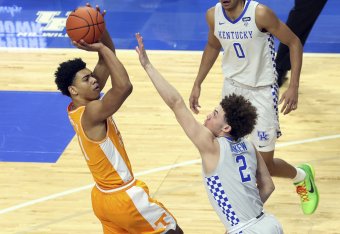
Jaden Springer moved into our top 10 for January's update—before he went for more than 20 points in three consecutive games.
Accurate three-point shooting has helped all season (53.6 percent, 6-of-12 last three games), but Springer has become more comfortable navigating and scoring in the half court, using his change of direction and speed, the timing of his moves and is body control/balance while getting into shots for creation and shot-making.
His defense has become another major plus, with Springer contesting shots and making plays, demonstrating strong technique with the size (6'4", 204 lbs) and length conducive for defending at the next level.
It's understandable to question whether he has the playmaking chops or wiggle for a full-time point guard. But Springer, who had seven assists on Saturday against LSU, is too versatile at both ends to nitpick at positional question marks.
6. Keon Johnson (Tennessee, SG, Freshman)
9 of 14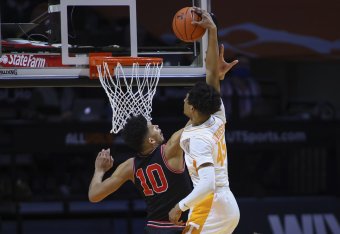
Keon Johnson started the season top-10 on our board, even with the understanding that he's raw and unlikely to consistently produce. But now he is, and his progress offensively is making it easier to buy/expect more from the 18-year-old off-guard.
Averaging 14.8 points per game in February, Johnson has started to complement his signature downhill play with more mid-range moves into touch shots.
Though mostly a transition and spot-up scorer for Tennessee, where a deep roster limits him to just 7.9 shot attempts per game, he's still making them in a variety of ways, having converted five field goals as a pick-and-roll ball-handler, seven from off-ball screens, seven out of isolation, seven from the post and 10 as a cutter.
Distance shooting is the one concern with Johnson. But he's made four threes over Tennessee's last four games, and he shown enough signs of hope for an established slasher, second-level scorer, plus passer and high-motor defender.
5. Jonathan Kuminga (G League Ignite, SF/PF, 2002)
10 of 14To most NBA evaluators who hadn't seen much of Jonathan Kuminga before his Ignite debut, he was more of an idea than a well-scouted prospect. That idea has come to life in the G League bubble, where the 6'8" combo forward has averaged 18.3 points and 3.3 assists through four games, scoring from three levels while showcasing unexpected passing skills.
He's given defenders problems out of isolation, surprising them with his first step or using spin moves to blow by them toward the rim. For a 220-pounder, he's tougher to contain off the dribble than he looks, and he's used his elusiveness to draw attention and set up teammates.
It's harder to buy his three-ball (4-of-19) being reliable anytime soon. But he clearly has the confidence and ability to hit from behind the arc, and the early makes suggest the jumper will eventually become part of his every-game repertoire.
There are still some possessions where he'll catch and hold, and quicker wings have been able to lose him. But given his standout physical profile, Kuminga has produced with enough flashes of NBA-caliber moves to the point where it's worth discussing him in the same conversation as a top NCAA prospects on our board.
4. Jalen Green (G League Ignite, SG, 2002)
11 of 14It took Jalen Green one G League game to feel comfortable. Since debuting last week, he's scored at least 20 points in three consecutive Ignite matchups, looking more decisive when picking his spots to activate his lightning first step, explosive hops and dangerous pull-up game.
Even without skill, he's a threat to score just by sprinting in transition, attacking vulnerable closeouts and elevating around the paint, where he can bounce over defenders. But his shot has looked clean so far, particularly when he's been able to set his feet off the catch or dribble.
His ball-handling and decision-making could use tightening, as he's turned it over trying to squeeze through small windows. But overall, Green has showcased elite athleticism and a shot-making ability that hint at scoring upside. And he's made some promising reads as a passer when given the chance to playmake, although Ignite is using Jarrett Jack and Daishen Nix on the ball often.
Continuing to show growth with his shot selection and his defense could eliminate the biggest questions scouts had before the bubble.
3. Evan Mobley (USC, C, Freshman)
12 of 14
There hasn't been a slump or a worrisome game all season that's raised a concern about Evan Mobley. He's consistently produced with convincing flashes of scoring versatility, defensive impact and overall fluidity that point to a star prospect and an easy NBA fit.
He's one of four freshmen on record (minimum 20 games) with box plus/minuses of 13 or more, joining Zion Williamson, Anthony Davis and Karl-Anthony Towns.
With valued NBA skills for a center (while only posting up 13.4 percent of the time), the 7-footer is 8-of-11 on spot-up drives to the basket, 9-of-17 on runners and shooting 41.9 percent on half-court jumpers. He's comfortable putting the ball down and finishing off face-up moves, whether they're into layups and dunks or touch shots around the key.
And the eye test buys his jumper long-term, at least to become a service weapon on a regular basis.
Also, his offense still isn't as strong of a selling point as his defense, with Mobley averaging 3.1 blocks to just 1.7 fouls per game while demonstrating scary, switchable foot speed away from the basket.
Even for a team already set at the 5 position, Mobley may appear to be too convincing to pass on at No. 2 or No. 3.
2. Jalen Suggs (Gonzaga, PG, Freshman)
13 of 14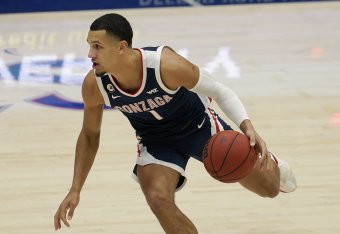
Despite some big performances from the G League Ignite prospects, Jalen Suggs still has the edge.
He has a well-rounded scouting report without any glaring holes, but I have more confidence in his potential to impact games, which he can do as a lead scorer and playmaker, defensive pest or energizer.
Offensively, Suggs' combination of turn-the-corner burst, passing skill and pull-up shooting (94th percentile) should suit him well as an NBA point-of-attack initiator. But he's also a threat from off the ball at both ends, using his athleticism and his instincts for cutting and defensive playmaking.
And after a short slump from three, he's now 8-of-20 over Gonzaga's last five games, helping to alleviate the only concern scouts may have had in January.
1. Cade Cunningham (Oklahoma State, PG, Freshman)
14 of 14
The gap between No. 1 and No. 3 is closer than it seemed before the season. But Cade Cunningham still holds the title of top projected prospect, shooting better than we anticipated while making passes that highlight more playmaking potential than his 3.5 assists per game may suggest.
While he's had trouble lately finishing in tighter spaces inside the arc, Cunningham has hit 18 of 36 threes over his last seven games for Oklahoma State. And now he ranks in the 95th percentile in isolation scoring, showing impressive ball-handling moves for separating into drives and dribble jumpers.
His assist numbers would look better if teammates were hitting more than 32.7 percent of his passes to them in spot-up situations. NBA teams figure to use Cunningham similar to the way the Dallas Maverick use Luka Doncic—as a jumbo ball-handler and high-level creator from either backcourt spot.
Stats courtesy of Synergy Sports, Sports-Reference.com.









